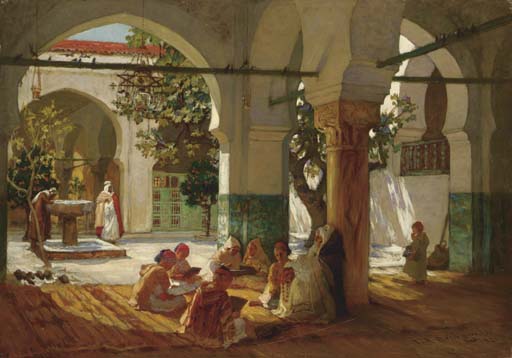Artist: Adolf Schreyer (German, 1828-1899)
Title: The Skirmish
Signed 'ad. Schreyer' (lower right)
Medium: oil on canvas
Size: 34¼ x 48 in. (87 x 121.9 cm.)
giovedì 16 luglio 2009
Adolf Schreyer, The Skirmish
Learning the Qur'an

Artist: Frederick Arthur Bridgman (American, 1847-1928)
Title: Learning the Qur'an, 1921
Signed and dated 'F. A. Bridgman 1921' (lower right)
Medium: oil on canvas
Size: 21¼ x 29¾ in. (54 x 75.6 cm.)
mercoledì 15 luglio 2009
Pieter Brueghel, The Tower of Babel (1563)
Pieter Brueghel, The Tower of Babel (1563).
"The Tower of Babel is the subject of two oil paintings by Pieter Bruegel the Elder. They depict the construction of the Tower of Babel, which according to the Book of Genesis in the Bible was a tower built by a unified, mono-lingual humanity as a mark of their achievement, and to prevent them from scattering: "Then they said, 'Come, let us build ourselves a city, and a tower with its top in the heavens, and let us make a name for ourselves; otherwise we shall be scattered abroad upon the face of the whole earth.'" (Genesis 11:4)."
[Wikipedia]
Arnold Böcklin, Isle of the Dead (1880)
Arnold Böcklin, Isle of the Dead (1880).
"Isle of the Dead (German: Die Toteninsel) is the best known painting of Swiss Symbolist artist Arnold Böcklin (1827-1901). Prints of the work were very popular in central Europe in the early 20th century — Vladimir Nabokov observed that they were to be "found in every Berlin home."[1] Böcklin produced several different versions of the mysterious painting between 1880 and 1886.
All versions of Isle of the Dead depict a desolate and rocky islet seen across an expanse of dark water. A small rowboat is just arriving at a water gate and seawall on shore.[2] An oarsman maneuvers the boat from the stern. In the bow, facing the gate, is a female figure clad entirely in white which stands upright just behind her husband's white, festooned coffin. The tiny islet is dominated by a dense grove of tall, dark cypress trees — associated by long-standing tradition with cemeteries and mourning — which is closely hemmed in by precipitous cliffs. Furthering the funerary theme are what appear to be sepulchral portals and windows penetrating the rock faces. The overall impression conveyed by the imagery is one of both hopeless desolation and tense expectation." [Wikipedia]
Iscriviti a:
Post (Atom)



